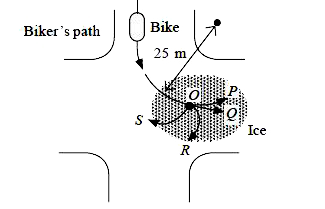A police jeep is chasing a culprit going on a motorbike. The motorbike crosses a turning at a speed of 72kmh−1. The jeep follows it at as peed of 108 kmh^-1, crossing the turning ten seconds later than the bike. Assuming that they travel at constant speeds, how far from the turning will the jeep catch up with the bike.
Step by step video & image solution for A police jeep is chasing a culprit going on a motorbike. The motorbike crosses a turning at a speed of 72 kmh^-1. The jeep follows it at as peed of 108 kmh^-1, crossing the turning ten seconds later than the bike. Assuming that they travel at constant speeds, how far from the turning will the jeep catch up with the bike. by Maths experts to help you in doubts & scoring excellent marks in Class 12 exams.
Updated on:21/07/2023Similar Questions
A police jeep is chasing a culprit going on a motorbike. The motorbike crosses a turning at a speed of 72 km/h.
The jeep follows it at a speed of 90 km/h, crossing the turning ten seconds later than the bike. Assuming that they travel at constant speeds, how far from the turning will the jeep catch up with the bike?
View SolutionA police is chasing a culprit going in a motorbike. The motorbike crosses a turning at a speed of 72 km/h.
The jeep follows it at a speed of 90 km/h, crossing the turning 10 seconds later than the bike. Assuming that they travel at constant speeds, how far from the turning will the jeep catch up with the bike?
View Solution
Knowledge Check
A thief is running away on a straitht road in a moving with a speed of 9ms−1. A policeman chases him on a motor cycle moving at a speed of 10ms−1. If the instananeous separation of the jeep from the motor cycle is 100m, how long will it take for the policeman to catch the thief ?.
A1sB19sC90sD100sA man can swim with a speed of 4kmh−1 in still water. He crosses a river 1km wise that flows steadily at 3kmh−1. If he makes his strokes normal to the river current, how far down the river does he go when he reaches the other bank?
A500mB600mC750mD850m
A police is chasing a culprit going n a motorbike. The motorbike crosses a turning at a speed of 72 km/h.
The jeep follows it at a speed of 90 km/h, crossing the turning tenseconds latert than the bike. Assuming that they tavel at constant speeds, how far from the turning will the jeep catch up with the bike?
View SolutionA thief's car moving on a straight road with a speed of 80km/h it is followed by a police car moving at a constant speed of 120km/h, crossing a T-point 20s later than the thief's car. At what distance from the T-point the police car will catch the thief's car?
View SolutionA motorbike travelling at a constant speed turns at an intersection. The bike follows a horizontal circular path with a radius of 25 m as shown in the figure. At point O, the bike hits an area of ice and loses all frictional forces on its tyres. Which path does the bike follow on the ice?

View SolutionA thief is running away on a straitht road in a moving with a speed of 9ms−1. A policeman chases him on a motor cycle moving at a speed of 10ms−1. If the instananeous separation of the jeep from the motor cycle is 100m, how long will it take for the policeman to catch the thief ?.
View SolutionA man can swim with a speed of 4kmh−1 in still water. He crosses a river 1km wide that flows steadly at 3kmh−1. If he makes his strokes normal to the river current, how far down the river does he go when he reaches the other bank?
View SolutionA police jeep, approaching a right-angled intersection from the north, is chasing a speeding car that has turned the corner and is now moving straight east. When the jeep is 0.6km north of the intersection and the car is 0.8km to the east, the police determine with radar that the distance between them and the car is increasing at 20kmh−1. If the jeep is moving at 60kmh−1 at the instant of measurement, what is the speed of the car?
View Solution
